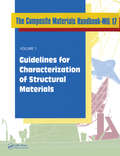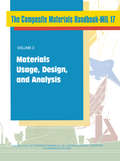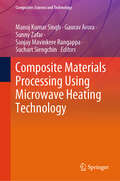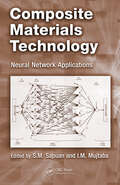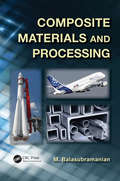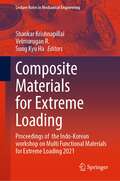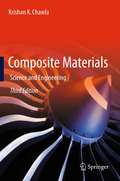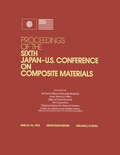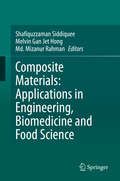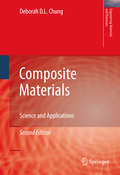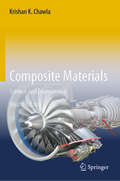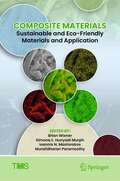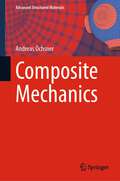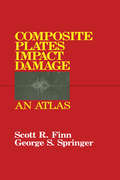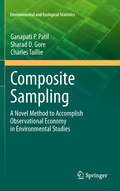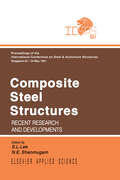- Table View
- List View
Composite Materials Handbook-MIL 17, Volume I: Guidelines for Characterization of Structural Materials
by UsDeptOfDefenseThis handbook documents engineering methodologies for the development of standardized, statistically -based material property data for polymer matrix composite materials. Also provided are data summaries for a number of relevant composite material systems for which available data meets specific MIL-HNBK-17 requirements for publication. Additionall
Composite Materials Handbook-MIL 17, Volume III: Materials Usage, Design, and Analysis
by UsDeptOfDefenseThis standardization handbook has been developed and is being maintained as a joint effort of the Department of Defense and the Federal Aviation Administration. It provides guidelines and material properties for polymer (organic) and metal matrix composite materials. This handbook aims to provide a standard source of statistically-based mechanical property data, procedures, and overall materials guidelines for characterization of composite material systems. This volume provides methodologies and lessons learned for the design, manufacture, and analysis of composite structures and for utilization of the material data provided in Volume II consistent with the guidance provided in Volume I. It covers processes and effects of variability; quality control of production materials; design and analysis; structural behavior of joints and reliability; thick section composites; and supportability.
Composite Materials Processing Using Microwave Heating Technology (Composites Science and Technology)
by Suchart Siengchin Gaurav Arora Sanjay Mavinkere Rangappa Manoj Kumar Singh Sunny ZafarThis book covers all aspects of composite materials processing and manufacturing using microwave heating technology and their applications in various industrial processes. Depending in the processing and material used, the composites are divided into three major segments: Metal matrix composites (MMCS), ceramics composites (CMCS), and polymer matrix composites (PMCS), respectively. During the manufacturing process of these composite materials, conventional heating technologies are used in which the heat is transferred from the electrical resistance coils to the material via conventional modes of heat transfer. Issues like non-uniform temperature distribution, poor curing efficiency, generation of the in-process scrap, long process cycle, high energy consumption and cost make traditional manufacturing route a difficult choice to select. Recently, microwave-assisted heating has emerged as a promising route for the fabrication of composites as a cost-effective environmentally sustainablemanufacturing process that yields improved mechanical properties which is the main topic of this book. It looks into the mechanism, salient features, and important aspects of microwave heating and their interaction with different composites materials. It also presents other manufacturing processes of various composites using microwave heating during casting, drilling, recycling, sintering, material joining, surface engineering. This book will appeal to students, researchers and scientists working in the area of composite materials processing and manufacturing.
Composite Materials Technology: Neural Network Applications
by S. M. Sapuan I. M. MujtabaArtificial neural networks (ANN) can provide new insight into the study of composite materials and can normally be combined with other artificial intelligence tools such as expert system, genetic algorithm, and fuzzy logic. Because research on this field is very new, there is only a limited amount of published literature on the subject.Compiling in
Composite Materials and Joining Technologies for Composites, Volume 7: Proceedings of the 2012 Annual Conference on Experimental and Applied Mechanics
by Eann Patterson Gary Cloud David BackmanComposite Materials and the First International Symposium on Joining Technologies for Composites, Volume 7: Proceedings of the 2012 Annual Conference on Experimental and Applied Mechanics represents one of seven volumes of technical papers presented at the Society for Experimental Mechanics SEM 12th International Congress & Exposition on Experimental and Applied Mechanics, held at Costa Mesa, California, June 11-14, 2012. The full set of proceedings also includes volumes on Dynamic Behavior of Materials, Challenges in Mechanics of Time -Dependent Materials and Processes in Conventional and Multifunctional Materials, Imaging Methods for Novel Materials and Challenging Applications, Experimental and Applied Mechanics, Mechanics of Biological Systems and Materials and, MEMS and Nanotechnology.
Composite Materials and Joining Technologies for Composites, Volume 7: Proceedings of the 2012 Annual Conference on Experimental and Applied Mechanics (Conference Proceedings of the Society for Experimental Mechanics Series #44)
by Eann Patterson Gary Cloud David BackmanComposite Materials and the First International Symposium on Joining Technologies for Composites, Volume 7: Proceedings of the 2012 Annual Conference on Experimental and Applied Mechanics represents one of seven volumes of technical papers presented at the Society for Experimental Mechanics SEM 12th International Congress & Exposition on Experimental and Applied Mechanics, held at Costa Mesa, California, June 11-14, 2012. The full set of proceedings also includes volumes on Dynamic Behavior of Materials, Challenges in Mechanics of Time -Dependent Materials and Processes in Conventional and Multifunctional Materials, Imaging Methods for Novel Materials and Challenging Applications, Experimental and Applied Mechanics, Mechanics of Biological Systems and Materials and, MEMS and Nanotechnology.
Composite Materials and Processing
by M. BalasubramanianComposite Materials and Processing provides the science and technology of processing several composites using different processing methods, and includes collective information on the processing of common and advanced composite materials. It also weighs the advantages and disadvantages of various processing methods. This book is suitable for materia
Composite Materials for Extreme Loading: Proceedings of the Indo-Korean workshop on Multi Functional Materials for Extreme Loading 2021 (Lecture Notes in Mechanical Engineering)
by Shankar Krishnapillai Velmurugan R. Sung Kyu HaThis book presents the select proceedings of the Indo-Korean workshop on Multi Functional Materials for Extreme Loading, 2021. The book mainly focuses on the very important emerging area of response to extreme loading of composites as well as other materials involving characterization studies, failure mechanisms conditions under quasi static to high strain rates, impact loads, blast loads, crash analysis, and other thermal and fatigue loads. The book also includes other important areas related to special materials and techniques such as 3D printing, nano-composites, multifunctional materials, and high temperature materials. The contents of this book are useful for beginners, industrial designers, academic researchers, and graduate students.
Composite Materials for Food Packaging: Innovative And Environmentally Sound Strategies (Insight to Modern Food Science)
by Umile Gianfranco Spizzirri Giuseppe Crillo Marek KozlowskThe book is intended as an overview on the recent and more relevant developments in the application of composite materials for food packaging applications, emphasizing the scientific outcome arising from the physico-chemical properties of such engineered materials with the needs of food quality and safety. Consumers are increasingly conscious of the strong relationship between food quality and health, and thus the request of packaging materials allowing the quality and safety of foods to be highly preserved. As a result, scientists from both academia and industry work to increase the quality of the food storage, with this book meant as a link between scientific and industrial research, showing how the development in composite materials can impact the field. In the book, the inorganic materials employed for the preparation of composite material is extensively analyzed in terms of physico-chemical properties, environmental and reusability concerns, as well as food interaction features, highlighting the importance and the potential limitations of each approach.
Composite Materials, 3rd Edition: Science and Engineering (Materials Research And Engineering Ser.)
by Krishan K. ChawlaThe third edition of Krishan Chawla's widely used textbook, Composite Materials, offers integrated and completely up-to-date coverage of composite materials. The book focuses on the triad of processing, structure, and properties, while providing a well-balanced treatment of the materials science and mechanics of composites. In this edition of Composite Materials, revised and updated throughout, increasing use of composites in industry (especially aerospace and energy) and new developments in the field are highlighted. There is a new chapter on non-conventional composites, which covers polymer, metal and ceramic matrix nanocomposites, self-healing composites, self-reinforced composites, biocomposites and laminates made of metals and polymer matrix composites. The third edition, featuring all figures in color, also includes new solved examples and problems as well as increased coverage of: Carbon/carbon brakes. Composites for civilian aircraft and jet engines. Second generation high-temperature superconducting composites. Composites for use in windmill blades. WC/metal particulate composites. Examples of practical applications in various fields are given throughout the book, and extensive references to the literature are provided. The book is intended for use in graduate and upper-division undergraduate courses, and as a reference for the practicing engineers and researchers in industry and academia.
Composite Materials, 6th Japan US Conference
by Air Force Office of Scientific Research Army Research Office Office of Naval Research 3M Corporation Virginia Institute for Material Systems Center for Adhesive and Sealant ScienceThis book contains technical papers, presented at the Sixth Japan-U.S. Conference on Composite Materials held in Orlando in 1982, on various topics, including stress analysis, interfaces and material systems, micromechanics, structural analysis, design and optimization, and strength analysis.
Composite Materials: A Vision for the Future
by Luigi Nicolais Michele Meo Eva MilellaComposite Materials presents recent developments and state-of-the-art achievements in the science and technology of composites. It identifies and discusses key and emerging issues for future progress in the multidisciplinary field of composites. By bringing together leading experts and promising innovators from research institutions and academia, Composite Materials highlights unresolved issues and identifies opportunities for long-term research needs to provide the reader with a vision for the future in various fields of application of composite materials. A few of the many future directions highlighted in the book are increasingly multifunctional properties; complex, hybrid and nanoreinforced materials; and tailoring in multiple dimensions and directions. The wider areas covered include, but are not limited to, the following: biomedical engineering,civil engineering,aerospace engineering,automotive engineering, andnaval engineering.Composite Materials is designed to increase the reader's understanding of the state of the art of composite materials in a variety of industrial sectors and to explore future needs and opportunities. It will therefore be of use to professionals working in the composites industry, research centers, and academia, who already have a graduate-level knowledge of composite materials.
Composite Materials: Applications in Engineering, Biomedicine and Food Science
by Shafiquzzaman Siddiquee Md. Mizanur Rahman Melvin Gan Jet HongComposite materials are formed when the combination of separate materials acquire new properties distinct from its components. They have a range of applications in fields such as mechanical and electrical engineering, food science and biomedicine and represent a fast-growing area of research. Composite Materials: Applications in Engineering, Biomedicine and Food Science provides an overview of current technologies and applications related to composite materials in these fields. Organized by discipline, the text encompasses a wide variety of composite materials, including polymer, ceramic, biomaterial, hydroxyapatite, nanofiber and green composites. Early chapters detail the enhanced mechanical, magnetic, dielectric properties of electrical and thermal conductive composite materials, which are essential in daily science. Subsequent chapters focus on filler or reinforcement materials, including carbon materials, hybrid materials and nanomaterials. Particular emphasis is placed on nanocomposite materials, as these have increasingly diverse field applications. Various manufacturing methods, such as the synthesis method and top-down/bottom-up manufacturing, are also discussed. Coverage of the recent progress, challenges and opportunities surrounding composite materials make this text a one-stop reference for engineers, scientists and researchers working in this exciting field.
Composite Materials: Design and Applications
by Daniel GayFor decades, Composite Materials: Design and Applications has guided readers on the efficient design of structural composite parts and has illustrated challenges encountered in modern engineering practice. The fourth edition of this perennial best-seller retains its pedagogical structure, featuring a technical level that rises in difficulty as the text progresses, while allowing each part to be explored independently, but has been updated to mirror recent advances and developments in manufacturing processes and applications. Gives numerous examples of the pre-sizing of composite parts, processed from industrial cases and reworked to highlight key information Provides a design method to define composite multilayered plates under loading, along with all numerical information needed for implementation Includes test cases for the validation of computer software using finite elements Proposes original study of composite beams of any section shapes and of transverse shear behavior of laminates, leading to technical formulations that are not found in the literature Reflects the latest manufacturing processes and applications in the aerospace, automotive, naval, wind turbine, and sporting goods industries, and now features new details on the recycling of composites and additive manufacturing Offers new coverage of ceramic-matrix composites and new concepts for design of laminates, including Double-Double and tapered laminates by means of Tsai homogenization This book serves as a textbook for advanced students studying composite materials design, as well as a handy reference for industry professionals working with composite materials.
Composite Materials: High Strain Rate Studies
by R. Velmurugan, Dong Ruan and S. GurusideswarSummarizing the recent advances in high strain rate testing, this book discusses techniques for designing, executing, analyzing, and interpreting the results of experiments involving the dynamic behavior of multifunctional materials such as metals, polymers, fiber-reinforced polymers, hybrid laminates and so forth. The book also discusses analytical and numerical modeling of materials under high-velocity impact loading and other environmental conditions. Recent advances in characterization techniques such as digital image correlation and computed tomography for high strain rate applications are included. Features Presents exclusive material on high-rate properties of fiber-reinforced composites Provides numerical techniques on the analysis and enriched data on the high strain rate behavior of materials Explores cutting-edge techniques and experimental guidelines for an array of different materials subjected to high strain rate loading Explains clear understanding of material behavior at various strain rates Reviews mechanical response of different materials at high strain rates This book is aimed at researchers and professionals in mechanical, materials, and aerospace engineering.
Composite Materials: Mechanics, Manufacturing and Modeling
by Sumit SharmaComposite materials find diverse applications in areas including aerospace, automotive, architecture, energy, marine and military. This comprehensive textbook discusses three important aspects including manufacturing, mechanics and dynamic mechanical analysis of composites. The textbook comprehensively presents fundamental concepts of composites, manufacturing techniques and advanced topics including as advances in composite materials in various fields, viscoelastic behavior of composites, toughness of composites and Nano mechanics of composites in a single volume. Topics such as polymer matrix composites, metal matrix composites, ceramic matrix composites, micromechanical behavior of a lamina, micromechanics and nanomechanics are discussed in detail. Aimed at senior undergraduate and graduate students for a course on composite materials in the fields of mechanical engineering, automobile engineering and electronics engineering, this book: Discusses mechanics and manufacturing techniques of composite materials in a single volume. Explains viscoelastic behavior of composites in a comprehensive manner. Covers fatigue, creep and effect of thermal stresses on composites. Discusses concepts including bending, buckling and vibration of laminated plates in detail. Explains dynamic mechanical analysis (DMA) of composites.
Composite Materials: Properties, Characterisation, and Applications
by Pramod Kumar Singh Amit Sachdeva Hee Woo RheeComposite Materials: Properties, Characterisation, and Applications provides an in-depth description of the synthesis, properties, and various characterisation techniques used for the study of composite materials. Covers applications and simulation tests of these advanced materials Presents real-world examples for demonstration Discusses surface, thermal, and electrical characterisation techniques Covers composites for use as sensors Aimed at industry professionals and researchers, this book offers readers thorough knowledge of the fundamentals as well as advanced level techniques involved in composite material characterisation, development, and applications.
Composite Materials: Science and Applications (Engineering Materials and Processes)
by Deborah D. ChungThe first edition of "Composite Materials" introduced a new way of looking at composite materials: covering composites in accordance with their functions. This second edition expands the book's scope to emphasize application-driven and process-oriented materials development. This tutorial-style reference book examines both structural composite materials and functional composite materials, as needed for a substantial range of applications. The emphasis on application-driven and process-oriented materials development is enhanced by a large amount of experimental results that provide real illustrations of composite materials development. "Composite Materials" is an essential book for researchers and engineers who are interested in materials development for industrial applications. It has a vibrant yet functional approach, making it suitable for both students and practitioners, and provides a full explanation of all of the fundamental concepts related to the structural and functional properties covered.
Composite Materials: Science and Engineering (Materials Research And Engineering Ser.)
by Krishan K. ChawlaThe fourth edition of Krishan Chawla's widely used textbook, Composite Materials, offers integrated and completely up-to-date coverage of composite materials. The book focuses on the triad of processing, structure, and properties, while providing a well-balanced treatment of the materials science and mechanics of composites. In this edition of Composite Materials, revised and updated throughout, increasing use of composites in industry (especially aerospace and energy) and new developments in the field are highlighted. New material on the advances in non-conventional composites (which covers polymer, metal and ceramic matrix nanocomposites), self-healing composites, self-reinforced composites, biocomposites and laminates made of metals and polymer matrix composites is included. Examples of practical applications in various fields are provided throughout the book, with extensive references to the literature. The book is intended for use in graduate and upper-division undergraduate courses and as a reference for the practicing engineers and researchers in industry and academia.
Composite Materials: Sustainable and Eco-Friendly Materials and Application (The Minerals, Metals & Materials Series)
by Simona E. Hunyadi Murph Brian Wisner Ioannis N. Mastorakos Muralidharan ParamsothyThis collection covers innovations in the field of composite materials with a specific focus on eco-friendly and environmentally sustainable systems. All composite fields are explored, including polymer, metal, and ceramic matrix composites with an emphasis on sourcing raw materials in a sustainable way as well as the development of composite materials for environmental sustainability. Topics will include the development of new materials for structural applications, reduction in energy consumption, and increased component life along with discussions of novel methods to reuse existing materials. Additional topics include, but are not limited to:· Naturally Sourced Materials feedstock · Recycled Material feedstock, · Application of composite for reduced carbon footprint · Development of novel materials to repurpose waste from other areas
Composite Mechanics (Advanced Structured Materials #184)
by Andreas ÖchsnerThis book in the advanced structured materials series provides first an introduction to the mircomechanics of fiber-reinforced laminae, which deals with the prediction of the macroscopic mechanical lamina properties based on the mechanical properties of the constituents, i.e., fibers and matrix. Composite materials, especially fiber-reinforced composites, are gaining increasing importance since they can overcome the limits of many structures based on classical metals. Particularly, the combination of a matrix with fibers provides far better properties than the constituents alone. Despite their importance, many engineering degree programs do not treat the mechanical behavior of this class of advanced structured materials in detail, at least on the bachelor’s degree level. Thus, some engineers are not able to thoroughly apply and introduce these modern engineering materials in their design process. The second part of this book provides a systematic and thorough introduction to the classical laminate theory based on the theory for plane elasticity elements and classical (shear-rigid) plate elements. The focus is on unidirectional lamina which can be described based on orthotropic constitutive equations and their composition to layered laminates. In addition to the elastic behavior, failure is investigated based on the maximum stress, maximum strain, Tsai-Hill, and the Tsai-Wu criteria. The introduced classical laminate theory provides a simplified stress analysis, and a subsequent failure analysis, without the solution of the system of coupled differential equations for the unknown displacements in the three coordinate directions. The book concludes with a short introduction to a calculation program, the so-called Composite Laminate Analysis Tool (CLAT), which allows the application of the classical laminate based on a sophisticated Python script.
Composite Plates Impact Damage: An Atlas
by ScottR. FinnThis is a unique X-ray atlas illustrating damage in composite plates caused by non-penetrating impacts. A valuable aid in designing composites for different types of impact resistance. Damage to composite materials caused by non-penetrating impact is often internal, invisible and difficult to detect. This atlas contains more than 400 revealing pictures of impact damage from a variety of loads under a variety of conditions. The parameters are varied systematically to produce useful, reliable design data.
Composite Sampling: A Novel Method to Accomplish Observational Economy in Environmental Studies (Environmental and Ecological Statistics #4)
by Sharad D. Gore Ganapati P. Patil Charles TaillieSampling consists of selection, acquisition, and quantification of a part of the population. While selection and acquisition apply to physical sampling units of the population, quantification pertains only to the variable of interest, which is a particular characteristic of the sampling units. A sampling procedure is expected to provide a sample that is representative with respect to some specified criteria. Composite sampling, under idealized conditions, incurs no loss of information for estimating the population means. But an important limitation to the method has been the loss of information on individual sample values, such as, the extremely large value. In many of the situations where individual sample values are of interest or concern, composite sampling methods can be suitably modified to retrieve the information on individual sample values that may be lost due to compositing. This book presents statistical solutions to issues that arise in the context of applications of composite sampling.
Composite Steel Structures: Advances, design and construction
by R. NarayananThe constant need for cost-effective structural forms has led to the increasing use of composite construction, and a substantial amount of research effort is currently being spent in developing techniques for combining concrete and steel effectively. Significant economies in this form of construction have been observed, especially in bridges and building floors. Codes of Practice on composite construction are being revised in the UK and in Europe, in the light of the substantial amount of knowledge that has been generated in recent years. An International Conference organised by the Department of Civil and Structural Engineering, University College, Cardiff, UK, with the specific objective of discussing all types of metal structures in an integrated way, provided a forum for the dissemination of new concepts and for reviewing developments; the expectations of the organisers have been amply justified and exceeded by the level of international response to the call for papers. This volume contains 17 papers on composite steel structures, presented at the Conference, many of which were by well-known experts in their respective fields.
Composite Steel Structures: Recent research and developments
by S L Lee N E ShanmugamProceedings of the International Conference on Steel and Aluminium Strucutres, ICSAS 91, Singapore 22-24 May 1991. The complete proceedings are available in three volumes: steel structures, aluminium structures and composite steel structures.The conference was organised by the Department of Civil Engineering, National University of Singapore sequel to the one held in Cardiff, UK in July 1987. It was co-sponsored by the International Association for Bridge and Structural Engineering, the Institution of Civil Engineers, the Institution of Engineers, Singapore, the Institution of Structural Engineers, the Steel Construction Institute, UK, the Singapore Structural Steel Society and the University of Wales College of Cardiff. The conference provided a forum to discuss recent advances and trends in the analysis, design and construction of all types of metal structures.This volume contains 18 of the papers presented at the conference. Invited Lectures on the state-of-the-art surveys have been provided by well-known experts in their respective fields. The coverage is extensive and topics include Bridges, Building Floor Systems, Concrete Filled Hollow Sections, Aluminium-concrete Systems, Composite Members to Earthquake Loading, etc.
